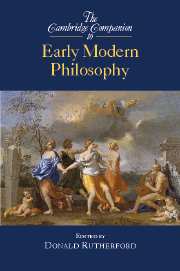Book contents
- Frontmatter
- Introduction
- 1 Innovation and orthodoxy in early modern philosophy
- 2 Knowledge, evidence, and method
- 3 From natural philosophy to natural science
- 4 Metaphysics
- 5 The science of mind
- 6 Language and logic
- 7 The passions and the good life
- 8 The foundations of morality: virtue, law, and obligation
- 9 Theories of the state
- 10 Theology and the God of the philosophers
- 11 Scholastic schools and early modern philosophy
- 12 Toward enlightenment: Kant and the sources of darkness
- Short biographies of major early modern philosophers
- Bibliography
- Index
- Series list
12 - Toward enlightenment: Kant and the sources of darkness
Published online by Cambridge University Press: 28 January 2007
- Frontmatter
- Introduction
- 1 Innovation and orthodoxy in early modern philosophy
- 2 Knowledge, evidence, and method
- 3 From natural philosophy to natural science
- 4 Metaphysics
- 5 The science of mind
- 6 Language and logic
- 7 The passions and the good life
- 8 The foundations of morality: virtue, law, and obligation
- 9 Theories of the state
- 10 Theology and the God of the philosophers
- 11 Scholastic schools and early modern philosophy
- 12 Toward enlightenment: Kant and the sources of darkness
- Short biographies of major early modern philosophers
- Bibliography
- Index
- Series list
Summary
The title page of Christian Wolff’s Vernünftige Gedancken von Gott, der Welt und der Seele des Menschen of 1720, the so-called “German Metaphysics,” shows a brilliant sun beaming through dark clouds above a peaceful rural landscape. A Latin phrase over the sun explains the picture: “light restored after clouds.” Many other philosophy books published in Germany during the first part of the eighteenth century carried similar pictures. In at least two the word Dispellam is shown at the top. Enlightenment or Aufklärung was the sun dispelling the clouds. The sun was reason; the clouds were ignorance and false belief. The darkness they caused was favorable to despotic government, overbearing priests, misguided religiosity, abusive nobility, repressive laws backed by ferocious punishments, unjust taxation, and stultifying economic practices. Enlighteners opposed these by trying to reform legislation, government, and penal systems, to increase religious toleration and the freedom to think and publish, to spread scientific knowledge, to improve education, and to rationalize economic policies. Success, they thought, depended on removing the dark clouds inherited from the past. Reason was the tool for the job. And philosophers were taken to be among those best equipped to show what reason could do and how it could help.
- Type
- Chapter
- Information
- The Cambridge Companion to Early Modern Philosophy , pp. 328 - 352Publisher: Cambridge University PressPrint publication year: 2006
- 1
- Cited by

